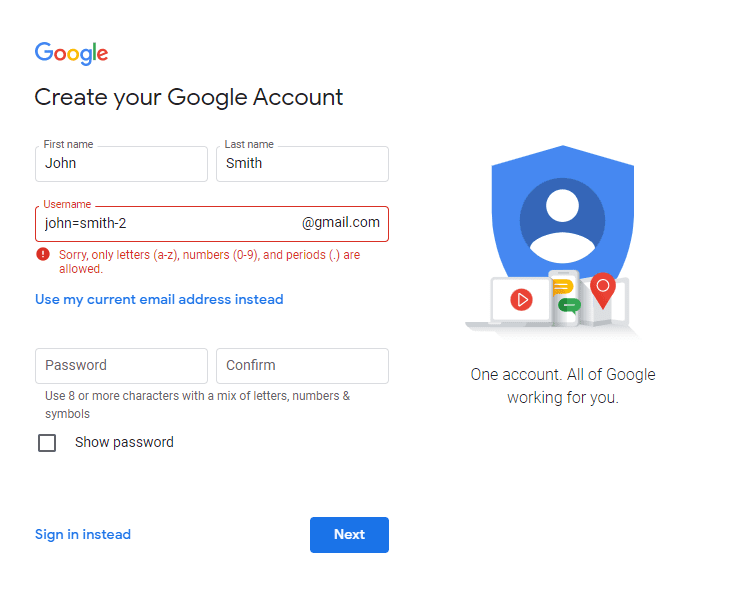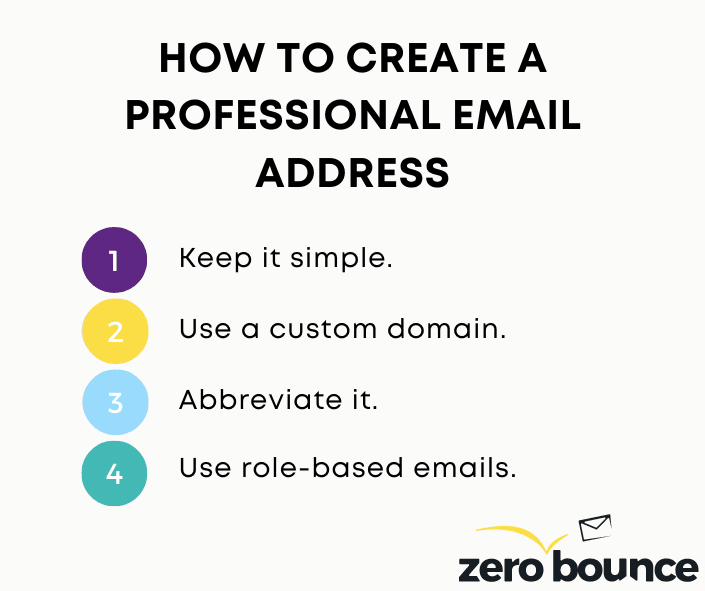
Email Address Format and How to Use it Right
Quick answer
The correct email address format consists of the following elements: a username (local part), a connecting ‘@’ symbol, a domain name, and a top-level domain (TLD). The elements before the ‘@’ symbol are called the ‘prefix,’ while everything after, including the domain and TLD, is called the suffix. The maximum length of an email address is 320 characters, allowing 64 characters in the username, one for the ‘@’ symbol, and 255 characters for the domain name.
Using the correct format of an email address is the key to ensuring its validity.
But how can you tell what letters, special characters or components make an email valid or invalid?
This essential guide will walk you through the following topics:
Table of contents
We’ll also give you some tips to help you create the perfect professional email address using the proper setup. In the end, you’ll be able to identify genuine email addresses from bogus ones quickly.
What are the components of a valid email address?
To better understand email address format, you need to know the four primary parts that make up a standard address.
- Username, or the local part – This is a word, phrase or name that uniquely distinguishes your address from others on the same domain
- @ symbol – The @ symbol bridges the connection between the username and the domain that owns it
- Domain – This is the organization’s name that shares an association with a specific mail server (i.e., Gmail, Yahoo, Outlook)
- Top-level domain (TLD) – The last part of the address that helps organize IP addresses by type (i.e., .com, .org, .edu)
We generally pair the domain and TLD and refer to them as the email suffix.
Note that some special emails may also contain a subdomain. This is a child domain of the parent domain and identifies a specific website. The subdomain follows the @ symbol (i.e., johnsmith@subdomain.domain.com).
When sending an email, your email server checks the username of the recipient’s email address with the corresponding server. For example, if you’re emailing “johnsmith@gmail.com,” it first inquires if the username “johnsmith” is valid on the Gmail domain.
If the email address is invalid or does not follow the correct email format, the message will bounce as there is no destination available.
Related: Are your contacts using the correct format for email? Find out for free!
The correct format for an email address
The valid format for an email address is as follows:
username@domain.tld
If you’re utilizing a subdomain, use the following format:
username@subdomain.domain.tld
Whether you’re creating an email for personal or professional use, you’ll always need to create a unique username to distinguish your address from others on a shared domain. The domain owns all those usernames, whereas the TLD organizes that domain into an appropriate category.
International email addresses outside the United States can vary depending on their origin. It’s not uncommon to see country abbreviations like UK or JP at the end of an email address, as follows:
username@domain.tld.uk
Be sure to verify if a contact uses an international identifier to make sure you’re following the correct email address format.
Syntax rules for the standard email format
While the basic structure of an email might seem simple, there are additional factors you need to consider.
The correct email username syntax
You can utilize any uppercase or lowercase letters, numbers or combinations thereof within an email username.
The rules for special characters vary depending on your email service provider (ESP).

For example, the Google email format prohibits the following:
- ampersand (&)
- equals sign (=)
- underscore ( _ )
- apostrophe (‘)
- dash (-)
- plus (+)
- comma (,)
- brackets (< >)
You also cannot use more than one period in succession nor end the username with one.
Zoho, Yahoo and Outlook email address formats allow more special characters, including those unallowed by Google. However, it’s best to avoid unnecessary characters like an additional (@) or ( / ) as these can make emails undeliverable depending on rules for the receiving server.
Regarding length, your username should never exceed 64 characters, according to the Internet Engineering Task Force (IETF) Request for Comments (RFC). If you attempt to create a Gmail account, Google locks you under 30.
This is important to note as some special characters, like a bracket (< >), count as two characters. You will again run into deliverability issues if you exceed the maximum email length for a complete address.
Equally important, you’ll want to keep your username short for convenience. The longer and more complicated your username is, the more likely people will make mistakes when entering it.
Periods and casing are mostly irrelevant
While you can place a period anywhere else in the username, it ultimately has no impact on the email format. If your address is john.smith@gmail.com, but someone enters johnsmith@gmail.com, the message will still arrive in your inbox. Just be sure not to use the periods back-to-back.
In the same way, email addresses are generally not case-sensitive. Even if your username contains capital letters, others can enter it in all lowercase and still reach your inbox.
What is the acceptable email domain syntax?
An email domain may contain uppercase or lowercase letters and numeric digits. You may also utilize a hyphen (-) or a period to identify sub-domains. However, you may not hyphenate at the beginning or end of the domain name.
The maximum total length for a domain is 255 characters.
What is the maximum length for the correct email format?
If you combine the upper limits of each email component, you will reach a maximum allowed length of 320 characters.
Username (64) + @ (1) + domain name (255) = 320 characters
However, the maximum size of an address in an email return or forwarding path is only 256 characters.
For this reason, we recommend considering 256 as the limit when creating an email address. This will ensure that you don’t encounter email deliverability issues when using your new address.
Examples of invalid and valid email format
To ensure that your new email addresses are valid, take a look at some examples of what email servers will allow or reject.
| Valid email prefixes | Invalid email prefixes |
| janedoe@gmail.com | jane..doe@gmail.com |
| support22@company.edu | john@support@company.edu |
| craig.smith02@outlook.com | craigsmith02-@outlook.com |
| Valid email suffixes | Invalid email suffixes |
| roger.d@outlook.com | roger.d@outlook |
| tom@newsletter.company.net | thomas22@newsletter.company |
| support@company.ca | john@support#company.ca |
Standard email format for creating a professional email address
It’s essential to follow the valid format for email addresses when forming a professional address. Failure to do so can cause issues with deliverability or lead to hard bounces. If people can’t contact you, they will forget about you.
In addition to the correct formatting rules, consider these tips when setting up your account.

Tip 1 – Keep it simple
No one wants to keep track of a complicated address. If your email address is long and contains several numbers or special characters, it’s easy to forget. It also looks unprofessional.
Let’s compare two addresses:
joexthecoolemailmarketer22@yahoo.com
joe.thompson@gmail.com
The first adds unnecessary words, symbols and numbers into the mix. It’s hard to remember and looks childish.
The latter is clean and concise. As long as your contacts remember your name, they can easily recognize your professional email address.
Tip 2 – Use a custom domain
This suggestion will help distinguish your professional address from generic contacts.
Most companies and organizations utilize a custom domain for this reason. They will set up a private email server using the company name as the domain name in their email address format. Not only does it elevate your perceived status, it naturally assists with brand awareness. When accepting new employment, find out if your company has a custom email domain. If you’re self-employed, consider setting one up.
Tip 3 – Try abbreviations
If you have a long or difficult-to-spell name, consider abbreviating it. It might also be worthwhile to shorten things for easier memorization.
Rather than using the format of “firstname.lastname.domain,” try one of these:
first_initial.last_name@domain
first_name.last_initial@domain
Tip 4 – Identify the company role when applicable
In some cases, you’re better suited to create a shared email address for multiple account managers. Examples of this might include your technical support or customer service teams.
For those addresses, keep it simple with something like support@company.com. Your customers can easily remember this, and multiple employees can manage the incoming queries.
This also works well for internal communications. To avoid missing critical communications, label departments accordingly (hr@company.com, marketing@company.com, etc.). All of these look professional while adhering to the proper email address format.
Make sure you’re following the email standard format with ZeroBounce
The best way to ensure the correct format for emails is through email validation. An email validation service can quickly identify invalid email addresses so that you can remove them from your list. Just upload your entire list of contacts in bulk, hit validate and get your results. Every business must verify their addresses to protect their bottom line.
You can also protect yourself from invalid addresses using an email verification API. If a potential connection fails to use the valid email address format, the API will automatically reject it.
It will protect you from unnecessary bounces and keeps your sender score in check.
Verify the email address format for 100 emails free!
Table of Contents
- Quick answer
- Table of contents
- What are the components of a valid email address?
- The correct format for an email address
- Syntax rules for the standard email format
- The correct email username syntax
- Periods and casing are mostly irrelevant
- What is the acceptable email domain syntax?
- What is the maximum length for the correct email format?
- Examples of invalid and valid email format
- Standard email format for creating a professional email address
- Tip 1 - Keep it simple
- Tip 2 - Use a custom domain
- Tip 3 - Try abbreviations
- Tip 4 - Identify the company role when applicable
- Make sure you're following the email standard format with ZeroBounce




